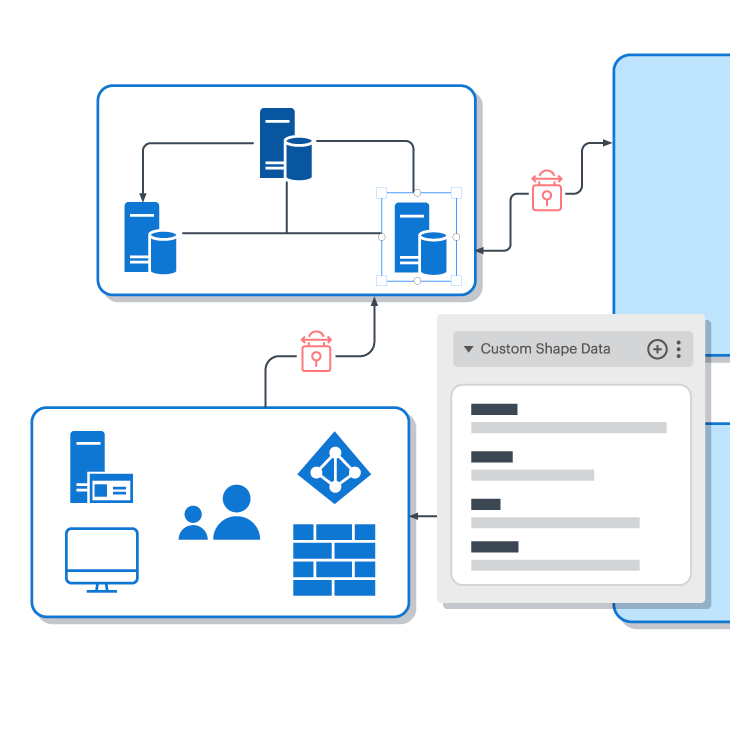Take a minute and remember your first day at a new job. How did you feel? Nervous? Stressed? Overwhelmed? Starting a new job comes with many challenges and much to learn, especially for engineers. Not only are there the usual names and faces to remember, but also a mountain of code to unravel, a new work process to master, and new technical systems to understand. Fortunately, with Lucidchart, employee onboarding for engineers is relatively painless and can have your new hires up to speed in no time.
Here are four onboarding best practices to consider as you make your new hire checklist, including ways you can use Lucidchart to expedite your onboarding process for engineers.
1. Create an org chart
Part of employee orientation includes an incredibly fast introduction to the existing teams—but all those names, faces, titles, and tenure can be nearly impossible to remember. After you introduce a new engineer to your team in person, give your new hires a cheat sheet to help them remember their new co-workers and what projects each of them are working on.
In Lucidchart, you can quickly create an org chart by dragging and dropping boxes manually, using text markup, or importing a CSV file. Use Group View to separate your org chart into scrum teams so new hires can understand who they will be working with.

Learn how to manage your scrum teams in Lucidchart.
Learn howCustomize your org chart to include pictures, job titles, and areas of expertise. Including photos and contact information will make it significantly easier for your new employees to familiarize themselves with your teams, especially if your engineering and IT orgs are large.

If you also add conditional formatting to your org chart, you can opt to include skills context so newly onboarded engineers will know exactly who to go to if—and when—they have questions.
2. Use diagrams to walk through networks, systems, and code
Before an engineer can hit the ground running on a project, they need to get up to speed on the network, systems, and code that they’ll be working on. Jumping right into it may be a daunting prospect for some, but you can ease this process by providing diagrams to help them follow along.
Including diagrams in your new hire checklist for engineers will enable your engineers to get through their onboarding more quickly and with a better idea of how your code works, how your systems communicate with each other, or what your existing cloud architecture looks like.

For example, you can use the following diagram types to onboard engineers so they can get up to speed and start contributing to your projects and initiatives faster:
- UML diagrams: A unified modeling language (UML) diagram depicts a system and how users or other systems interact with yours—a system could be a website, an app, or maybe a business process.
- Data flow diagrams: Using standardized circles, arrows, and text labels, you can map out entire processes and systems in a data flow diagram. These diagrams allow you to take any flow of information for a system into a concise and coherent diagram that is easily understood.
- Network diagrams: A network diagram is a visual representation of a computer or telecommunications network. It shows the components that make up a network and how they interact, including routers, devices, hubs, firewalls, etc.
- Cloud architecture diagrams: A cloud architecture diagram reflects how your cloud infrastructure is designed, depicting the different components of your front and backend platforms, delivery, and even the relationships between each of them.
Your new hires will be grateful to have these technical systems documented, as it helps them understand exactly what the learning curve will be as they onboard, what they’ll be working on, and how they can contribute on a tangible level. Having each of these areas documented, new engineers can use visuals in lieu of scrolling through lines and lines of source code, digging through cloud consoles, or relying on employees with tribal knowledge.

The biggest challenge in creating these diagrams is not because the information is unavailable. Instead, the challenge is often creating accurate diagrams of your code, systems, data flows, etc. and keeping them up to date. If these diagrams are not kept up to date, they will be rendered not useful. And worse, if you provide a new engineer with an out-of-date diagram, they may end up making recommendations and changes based on inaccurate information, potentially damaging existing work, resulting in countless errors and rework for your teams.
So, how do you maintain up-to-date and accurate diagrams to give engineers during their onboarding process? Fortunately, Lucidchart is cloud-based and allows multiple participants to edit documents simultaneously. This means that any time your team makes a change to the code base, they can document it on the master chart without having to worry about finding the most updated version or being overwritten by a co-worker. Documentation is not only possible, it’s easy, and your new hires will thank you later.
3. Explain your team’s process with a flowchart
Every organization has a different way of doing things, so starting a new job means learning a new process, if not multiple new processes. This could entail multiple different design processes, cross-functional team processes, troubleshooting processes, and more. Then, add on an extra layer of processes that belong to multiple different products or parts of your product. Very quickly, your new engineers can become incredibly overwhelmed—and rightfully so.
You can relieve a lot of anxiety for your new engineers by making it clear what your expectations are, not only regarding what they will be working on, but how. Create a flowchart in Lucidchart that demonstrates your basic—and complicated—workflows, such as incident response diagrams and CI/CD processes. If you don’t already have these diagrams created, you can build these diagrams from scratch, or get started faster by using templates available in the Lucidchart template gallery.
As needed, use Actions to link to separate pages within the same document and elaborate upon the details of a sub-process. You can even use Actions to link to external pages, such as Confluence pages or Jira tickets.
Your engineers will save a lot of time throughout the learning process if they don’t have to wonder what they are supposed to do next. Also, you and more tenured employees and teams will also save time, because new engineers won’t be relying on tribal knowledge employees to walk them through every process in the company. With all of today’s demands on technical teams and engineers, there simply isn’t time for holding the hands of engineers as they onboard.
4. Store diagrams in a central place
Now that you have a library of onboarding documents, store them all in a central location. By centralizing your resources and diagrams in Lucidchart, you can create a single source of truth—a location where new engineers know they can go when they have questions.
To keep your diagrams and important onboarding materials accessible, consider using the following Lucidchart features to centralize and ease onboarding for engineers:
Team folders
Keep important onboarding documents organized. Simply share a folder of diagrams, rather than multiple diagrams individually. You might even consider creating a dedicated onboarding team folder, complete with all the resources a new engineer will need.
Permissions
While you will eventually want your engineers to be editing documents as they develop ownership in new areas, you likely won’t want them editing—or accidentally editing documents as they’re familiarizing themselves with your systems, code, and processes.
Set specific permissions to keep users from editing documents they shouldn't be—create view-only document permissions, or allow comment access, so new engineers can ask questions where and when applicable.
Comments and @mentions
Even better, if your diagram doesn’t completely answer the questions a new engineer may have, they can leverage Lucidchart’s collaboration and communication features to @mention users—such as more tenured employees—and comment on specific shapes to ask specific questions about specific parts of a process.

This way, engineers who are onboarding know where to go for system and process resources, and your Lucidchart diagrams can also become a centralized location for communication as your engineers onboard and ask questions—all with the added context of a visual.
Integrations
Lucidchart integrates with Confluence, Jira, GitHub, G Suite, Microsoft Office (including Microsoft Teams), and Dropbox. By using these integrations, you can save your crucial onboarding documents wherever your team works most.
From now on, onboarding software engineers will be the least of your worries and theirs.

Kickstart your onboarding process for engineers in Lucidchart today.
Get startedAbout Lucidchart
Lucidchart, a cloud-based intelligent diagramming application, is a core component of Lucid Software's Visual Collaboration Suite. This intuitive, cloud-based solution empowers teams to collaborate in real-time to build flowcharts, mockups, UML diagrams, customer journey maps, and more. Lucidchart propels teams forward to build the future faster. Lucid is proud to serve top businesses around the world, including customers such as Google, GE, and NBC Universal, and 99% of the Fortune 500. Lucid partners with industry leaders, including Google, Atlassian, and Microsoft. Since its founding, Lucid has received numerous awards for its products, business, and workplace culture. For more information, visit lucidchart.com.

